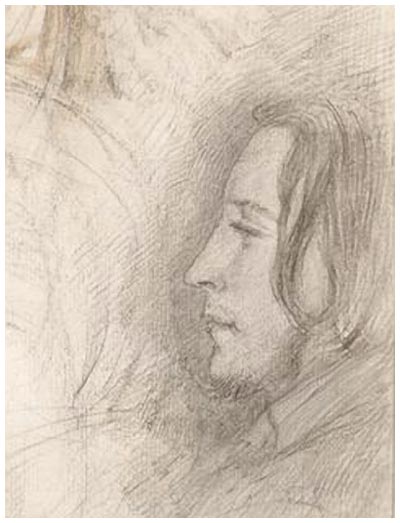Frédéric de Courcy

Frédéric de Courcy was a painter, born Alexandre-Frédéric Charlot de Courcy in Paris on March 28, 1832. His father, a writer of light comedies, was also known as Frédéric de Courcy. For the record, the cast of one of his plays, Le courrier de la malle ("The mail coach agent," written with M. de Rougemont and C. Dupeuty and published in 1832), featured Henry Monnier (1799–1877), an actor and playwright, but also a renowned artist in the heyday of nineteenth century French book illustration.
Like Gustave Moreau, William Bouguereau, Alexandre Cabanel and many others, Frédéric de Courcy studied painting with François-Édouard Picot (1786–1868), a neoclassic artist. He was a friend of Gustave Moreau, who drew his portrait on a study sheet for Hesiod and the Muse, and together they set out on a trip through Italy in 1857. The portrait was probably made sometime during this trip, possibly in 1858. Neither of them had won the prestigious Prix de Rome.[1] Nevertheless, they frequented the Villa Medici, where they attended the “evening academy”. Not only did these classes offer an appropriate environment for studying art, but provided them with opportunities to meet other artists, writers, etc.
Back in France, he started to exhibit at the Paris Salon in 1861 with a painting called La pâque (Passover). In 1863 and 1864 he exhibited two historical paintings, and in 1865 another painting inspired by Richardson’s Clarissa: Clarissa Harlowe Led by Lovelace to Sinclair’s House. He exhibited three more times at the Salon, from 1866 to 1868, but only enamelwork and most of it after Gustave Moreau: Œdipus and the Sphinx, La péri, etc. The turning of his interest to enamel was to determine his career as he moved to the Sèvres factory. There he taught ceramics and, for some time, directed research on translucent enamel. 1886 is a possible date for his death (see Virtual International Authority File).
OBI
-
- ^ The Prix de Rome was, at this time, a yearly contest for art students whose prizewinner was granted a three-year stay at the Academy of France in Rome, housed in the Villa Médicis since 1803.
- Image source: Photo (C) RMN-Grand Palais / René-Gabriel Ojeda.
